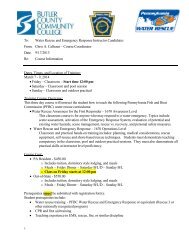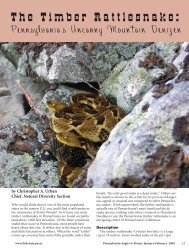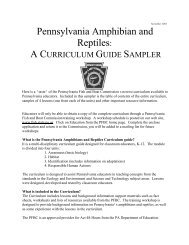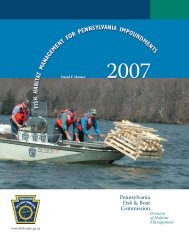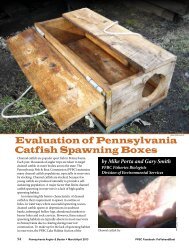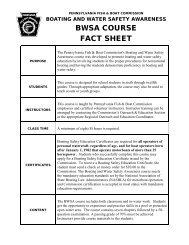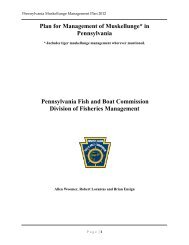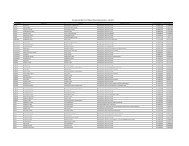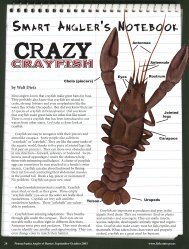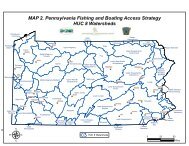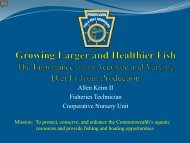march, 1968 - Pennsylvania Fish and Boat Commission
march, 1968 - Pennsylvania Fish and Boat Commission
march, 1968 - Pennsylvania Fish and Boat Commission
Create successful ePaper yourself
Turn your PDF publications into a flip-book with our unique Google optimized e-Paper software.
the basin <strong>and</strong> the sperm <strong>and</strong> eggs are gently agitated for<br />
two minutes. The fertilized eggs are then poured into a<br />
twenty gallon wooden keg half full of water. Ten quarts<br />
of eggs is considered maximum for each keg. The eggs<br />
<strong>and</strong> water are gently stirred with a turkey feather for one<br />
hour as the water is changed frequently to remove excess<br />
sperm, egg shells, ovariam material, <strong>and</strong> other foreign<br />
matter.<br />
After an hour the eggs are thoroughly washed <strong>and</strong> by<br />
then have water hardened to such an extent that they can<br />
be placed into a wooden tub (a siphon adds a constant<br />
flow of fresh water to the tub). The eggs are stirred every<br />
ten minutes to prevent them from adhering to one another<br />
<strong>and</strong> possibly forming clumps.<br />
MR. SHYRL HOOD, assistant chief, division of fisheries, explains<br />
to a group of youngsters the method used in spawning<br />
walleyes aided by the use of anesthetics. Hundreds of scheduled<br />
<strong>and</strong> non-scheduled groups visit the Linesville Hatchery totaling<br />
approximately 250,000 yearly.<br />
Five hours later the eggs are considered completely<br />
water hardened <strong>and</strong>, by now, will have doubled in size.<br />
They are then placed in hatching jars after being strained<br />
through a one-eighth inch screen to remove any clumped<br />
eggs or any other material that might interfere with proper<br />
rolling in the hatching jars.<br />
Two quarts of eggs are placed in each jar in a 72 jar<br />
battery. Approximately one gallon of water per minute<br />
enters the jar from the bottom through a vertical glass tube<br />
in the center of the jar. Flow is regulated to insure a continuous<br />
gentle rolling of all the eggs. Screen inserts are<br />
placed at the top of each jar to prevent eggs from washing<br />
away with the outflow.<br />
Water for the hatching comes from Pymatuning Lake,<br />
MARCH —1 968<br />
continued on page 26<br />
DAILY CHECK of trap nets in Pymatuning Sanctuary. Twelve<br />
nets are usually set at ice out in the spring <strong>and</strong> continued until<br />
June. Early in this period brood walleye—<strong>and</strong> muskellunge—<br />
are captured for spawning <strong>and</strong> approximately 25,000 pounds<br />
of panfish are salvaged <strong>and</strong> stocked in public fishing waters<br />
throughout <strong>Pennsylvania</strong>.<br />
SORTING <strong>and</strong> counting the catch as it comes in from the lake.<br />
The brood fish are transferred to the hatching building for<br />
spawning.<br />
RECORD KEEPING in connection with tagging programs. Data<br />
such as species, size, date, <strong>and</strong> location are recorded for future<br />
use.<br />
15




